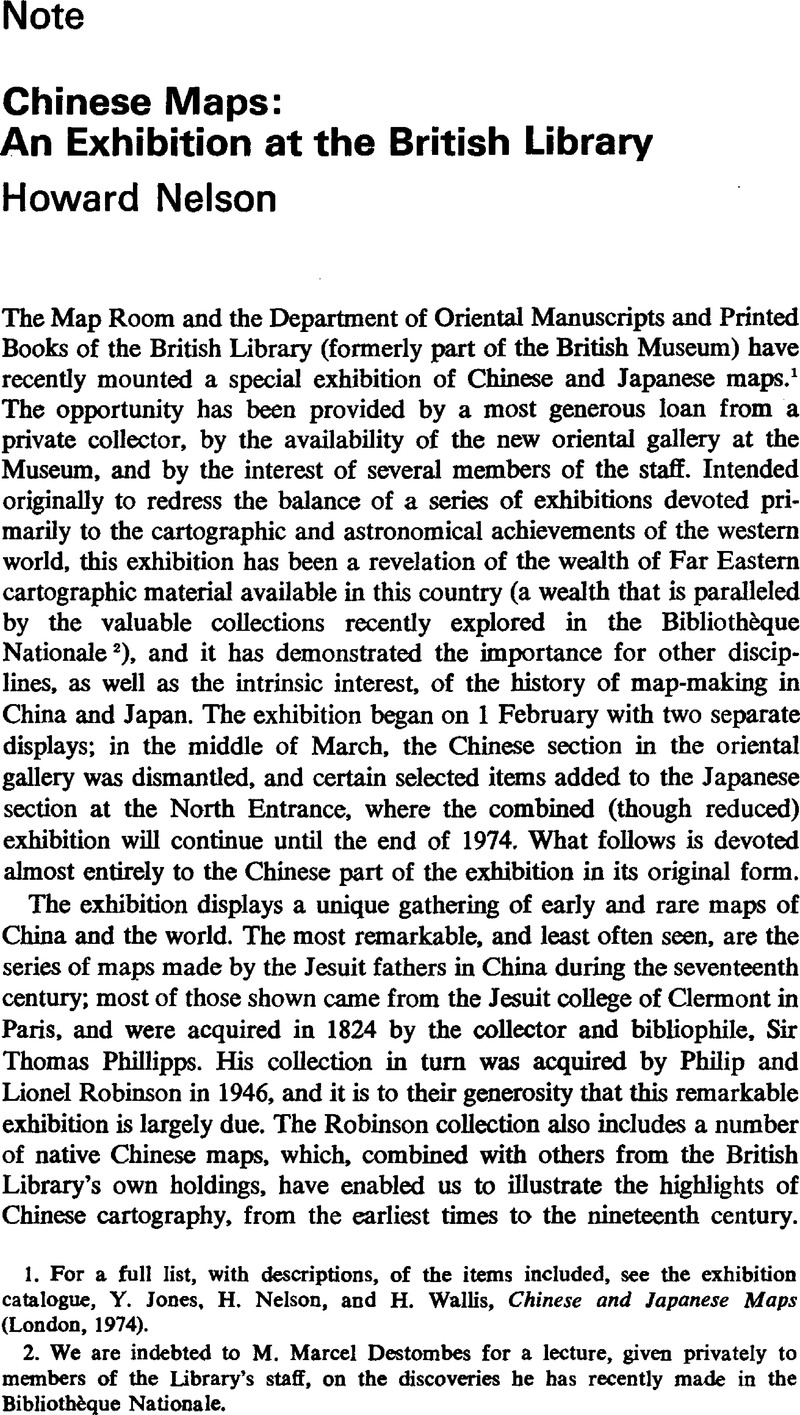Article contents
Chinese Maps: An Exhibition at the British Library
Published online by Cambridge University Press: 17 February 2009
Abstract

- Type
- Note
- Information
- Copyright
- Copyright © The China Quarterly 1974
References
1. For a full list, with descriptions, of the items included, see the exhibition catalogue, Jones, Y., Nelson, H., and Wallis, H., Chinese and Japanese Maps (London, 1974)Google Scholar .
2. We are indebted to M. Marcel Destombes for a lecture, given privately to members of the Library's staff, on the discoveries he has recently made in the Bibliotheque Nationale.
3. See the bibliography of Science and Civilisation in China (Vol. III) (Cambridge, 1959)Google Scholar for detailed references.
4. For accounts of these two maps, see Chavannes, E., “Les deux plus anciens specimens de la cartographie chinoise,” Bulletin de l'école française d'extréme orient, III (1903), p. 214CrossRefGoogle Scholar; and Soothill, W. E., “The two oldest maps of China extant,” Geographical Journal, LXIX (1927), p. 532CrossRefGoogle Scholar .
5. See Nakamura, H., “Old Chinese world maps preserved by the Koreans,” Imago Mundi, IV (1947), p. 3.Google Scholar
6. See Chavannes, E., “L'instruction d'un futur empereur de Chine en l'an 1193“ in Mdmoires concernant TAsie orientate, I (Paris, 1913), p. 19Google Scholar .
7. See Fuchs, W., The Mongol Atlas of China by Chu Ssu-pen and the Kuang Yü Tu (Monumenta Serica Monograph No. 8) (Peking, 1946)Google Scholar .
8. See, among other works on the sources and influences of the Jesuit cartographers in China, Helen Wallis, “The influence of Father Ricci on Far Eastern cartography,” Imago Mundi, XIX (1965), p. 38Google Scholar .
9. See Destombes, M., “Une carte de Chine d'époque Ming récemment découverte,” Gazette des Beaux Arts, 01 1974Google Scholar ; and a fuller study by the same author which is due to appear in Journal Asiatique, CCLXII.
10. This map was described for the first time by H. D. Talbot at the Third International Conference on the History of Cartography at Brussels in 1969, and an abstract of his paper appears in Imago Mundi, XXIV (1970), p. 95Google Scholar .
11. See the work of d'Elia, Pasquale, and especially his Il mappamondo cinese del P. Matteo Ricci S.J. (3a edizione, 1602) conservato presso la Biblioteca Vaticana (Rome, 1938)Google Scholar ; and “Recent discoveries and new studies (1938–1960) on the world map in Chinese of Father Matteo Ricci SJ,” Monumenta Serica, XX (1961), p. 83.
12. See Wallis, Helen, “The influence of Father Ricci”; and Wallis, Helen and Grinstead, E. D., “A Chinese terrestrial globe, A.D. 1623,” British Museum Quarterly, XXV, 3–4 (1962), p. 83CrossRefGoogle Scholar.
13. Father Boym's map is of especial interest, in that it is the first which includes both Chinese characters and romanized names. It is a draft which Boym intended for publication in his projected atlas of China, but the atlas was forestalled by the appearance of Martin Martini's Novus Atlas Sinensis in 1655. At this point, Jesuit cartography in China becomes Jesuit influence on European cartography of the world, including China; a separate, but equally interesting topic. Boym's work is most fully treated by Szczesniak, Boleslaw, “The atlas and geographic description of China: a manuscript of Michael Boym (1612–1659),” Journal of the American Oriental Society, LXXIII, 2 (1953), p. 65CrossRefGoogle Scholar .
14. The Jesuit maps themselves reveal a developing knowledge of the world: Ricci's version of 1602 shows Australia as part of a great undiSerentiated Southern Continent, whereas Verbiest's map of 1674 includes the information derived from Tasman's circumnavigation.
15. See Vining, E. P., An Inglorious Columbus (New York, 1885)Google Scholar .
16. Sir Alexander Hosie pointed out that the tradition of noting the existence of “barbarian” countries, without any regard to their geographical location, around the edge of a map of China, goes back to one of the two earliest extant maps, the Hua I T'u at Sian. See Soothill, W. E., “The two oldest maps of China extant,” p. 538Google Scholar .
17. There is a magnificent manuscript atlas of China, drawn for military purposes at the very end of the Ming dynasty, in the library of Eton College. This atlas is especially useful on Chinese attempts to repulse pirate attacks; and it may turn out that, overall, military needs provided the major spur for the making of maps.
- 3
- Cited by


